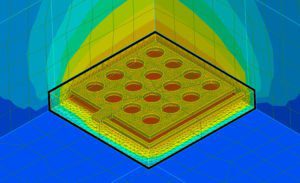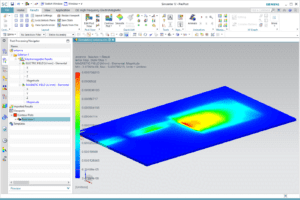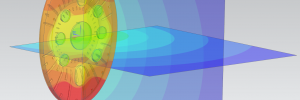
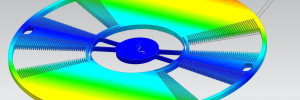
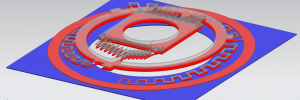
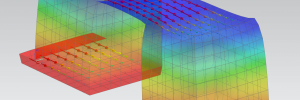
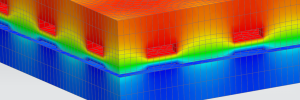
Available features
Here, you will find a broad list of physics and couplings available in the OOFELIE::Mutiphysics Solver.
Physics
The following physical fields are available in OOFELIE::Multipysics.
MechanicalThermalElectricalAcousticsFluidsTopology OptimizationMechanisms
- Static and transient
- Linear and non-linear
- Modal
- Real and complex
- Wet-mode shapes
- Harmonic
- Linear buckling
- Random vibrations
- Strength assessment
- Topology optimization
- Density based (SIMP)
- Iso- and orthotropic materials:
- Viscous, viscoelastic and structural damping
- Elasto-plastic, hyper-elastic non-linear materials
- Perfectly matched layers (PML)
- 3D modelling
- (Oriented) Volume, membrane, shell, rod, beam, lumped mass elements
- Large displacements & pre-stress
- Identical nodes, contact, perfect/non-perfect mechanical gluing, rigid body assemblies, mean
- Special effects:
- Coriolis
- Centrifugal
- 2-ways coupling with:
- Thermal field
- Electrical field
- 1-way coupling with optics
- Static (steady-state) and transient
- Linear and non-linear
- Topology optimization
- Density based (SIMP)
- 3D modelling
- Identical nodes, perfect/non-perfect thermal gluing, thermal contact admittance
- 3D mutual radiation (ray tracing)
- Orbital model
- 2-ways coupling with
- Mechanical field
- Electrical field
- Static and transient;
- Linear and non-linear
- FEM / BEM coupling
- Dielectric materials
- Identical nodes
- Perfect/non-perfect electrical gluing
- RLC, electric dipole elements
- 2-ways coupling with
- Mechanical field
- Thermal field
- Modal and Harmonic
- FEM/BEM coupling
- Acoustic Surface
- Acoustic Rayleigh Surface
- Acoustic material
- Viscous, Structural Damping, Perfectly matched layers (PML)
- Absorbent panel with frequency dependent admittance and impedance
- Plane wave excitation, Point acoustic source, Prescribed normal displacement, velocity, acceleration
- 2-ways coupling with mechanical field
- Static and Transient
- Linear
- Non-linear
- Any gas or liquid material (Newtonian behaviour)
- 3D, 2D planar and axisymmetric modelling
- Symmetry planes
- Incompressible, Boussinesq Law, Compressible subsonic & supersonic (FINE™/FSI-OOFELIE), Inviscid, Laminar viscous, Turbulent viscous (FINE™/FSI-OOFELIE)
- Boundary conditions
- Velocity and temperature at inlet
- Pressure at outlet
- Boundary conditions
- Non-slip flow
- Surface heat flux or temperature at walls
- 2-ways coupling with mechanical and thermal fields
- Physics
- Mechanical
- Thermal
- Static analysis
- Gradient based method with MMA optimizer
- Density-based approach
- Adjoint variable method for sensitivities computation
- Advanced SIMP laws
- Multimaterial with or without void
- Manufacturing constraint:
- Minimum member size
- Overhang
- Filters on:
- Sensitivities
- Densities
- Various objective and constraint functions
- Volume (Total or On specific material)
- Total mass
- Mechanical compliance
- Thermal compliance
- Displacement on points
- Rotation on points
- Temperature on points
- Eigen frequencies
- Uncertainty quantification in the model related to
- Loads definition
- Material properties specifications
- Non-linear transient analysis
- Rigid body
- Joints
- Hinge
- Cylindrical
- Prismatic
- Screw
- Universal
- Co-rotational approach
- Linear Super Element Models
- Multilayer multiphysics shell elements
- Mechanical mean
- Large rotations beam
- Controler definition
- PID
- LTI
- Preliminary support of FMU import
- Coupling with 3D mechanical elements
Couplings
The following couplings are accessible in OOFELIE::Multipysics.
Thermo-MechanicsOpto-Thermo-MechanicsCoupled Electrostatics-MechanicsPiezoelectricsPyro-PiezoelectricsVibroacouticsElectromagnetics – Low FrequencyElectro-Thermo-MechanicsElectromagnetics – High FrequencyHygro-Thermo-Mechanics
- Static and Transient
- Linear and non-linear
- Complex Modal and Harmonic
- 3D modelling
- Thermo-elastic iso- and orthotropic materials
- Thermo-elastic damping effect
- Thermal dependency of material properties
- 2-ways coupling with electric field
- 1-way coupling with optics
- Coupling with Zemax’ OpticStudio
Automated data exchange via in-memory dialog - Description of surface deformations:
Zernike Standard or Fringe polynomials, grid of points, all aperture types - Rigid body motion recognition and ability to export separately to Zemax’ OpticStudio
- Thermo-optic effect:
- Accounting for refractive index change as a function of Temperature.
- Computation and visualization of refractive index gradients inside lenses.
- Automated exportation to Zemax’ OpticStudio
- FEM/BEM coupling
- Mesh morphing
- Fast Multipole Methods for BEM
- Pre-stress
- Pull-in voltage computation
- Static and transient
- Linear and non-linear
- Modal and harmonic
- Piezoelectric materials:
- Hexagonal C6
- Trigonal D3
- Triclinic C1
- Perfectly matched layers (PML)
- (Oriented) Volume, membrane, shell
- 2-ways coupling with thermal
- 1-way coupling with optics
- Pyro- Piezoelectric materials:
- Hexagonal C6
- Trigonal D3
- Triclinic C1
- (Oriented) Volume
- 1-way coupling with optics
- Modal analysis
- Harmonic analysis coupled
- Complex direct
- Projection in coupled modal basis
- Projection in uncoupled modal bases
- Harmonic analysis uncoupled
- Uncoupled acoustic radiation
- Modes radiation efficiency computation
- FMM: Fast Multipole Method
- Vibroacoustic Interaction using Incompatible meshes
- Node-based interpolation
- Projection interpolation
- 2-ways coupling with Pyropiezoelectric
- 1-way coupling with Electromagnetic
- Electro-technical hypotheses
- Static and Transient
- Linear and non-linear
- Harmonic
- 3D, 2D planar and axisymmetric modelling
- Magnetic non-conductor and conductor, isolator, Active and Passive conductor
- Permanent magnet
- Inductor
- Given current direction, Axi-symmetric
- Electromotive source
- Current driven
- Potential driven
- Infinite extension medium, electromagnetic wire
- Coupling with Mechanical (Laplace force) and Thermal (Joule effect) fields
- Static and Transient
- Linear and non-linear
- Thermoelectric conductor isotropic
- Thermo-elastic electric conductor isotropic
- Peltier, Seebeck , Thomson, Piezo-resistive effects
- Joule Heating
- Thermal dependency of Electrical and Thermal conductivity
- Electromagnetic wave prpagation based on FDTD
- Dissipative materials
- PLM
- Conforme mesh
- S-parameters
- Coupled three-field simulation
Computational electromagnetics (CEM)
Electrokinetic thermomechanics
- Conduction current computation
- Joule effect heating with thermomechanical coupling
- Steady state or transient analysis
- No magnetic field is considered
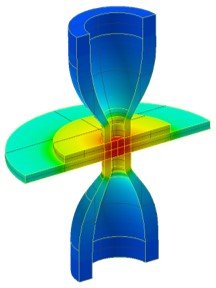
Electromagnetics - Low Frequency
- Magnetostatics (magnetic field constant in time)
- Source: Constant conduction current
- Source: Permanent magnet
- Electric field not influenced by magnetic field
- Magnetodynamics (magnetic field variable in time)
- Transient and harmonic analysis
- Electric and magnetic field are fully coupled
- Eddy current computation
- Couplings with mechanical field (Laplace force) and thermal field (Joule effect)
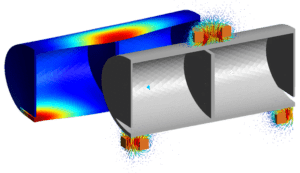
Electromagnetics - High Frequency
Full wave Maxwell’s Equations solver
- FDTD
- PML
- Tangent losses
- Near-field-to-far-field transformations
Electrostatics mechanics
- Computation of electrostatic forces using FEM or BEM
- FEM/FEM coupling with mechanics.
- Mesh morphing is available to account of large displacements of the structure.
- FEM/BEM coupling with mechanics.
- Fast Multipole Method available to accelerate large scale applications.
- Understand the effect of pre-stesses on the response of the system.
- Computation of the Pull-in voltage.
